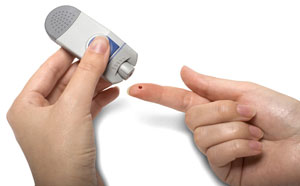Alpha Lipoic Acid and Diabetic Retinopathy

Around the world, rates of diabetes are high and growing. It is therefore not surprising that diabetic retinopathy is the leading cause of blindness. So what can be done to help prevent or treat this common eye condition? Some studies suggest that the antioxidant benefits of alpha lipoic acid may help slow down the progression of diabetic retinopathy. (iii.132)
Symptoms, Causes, and Screening for Diabetic Retinopathy
Over time 80% of people with type 1 diabetes are found to have diabetic retinopathy. The condition is even more common in those with type 2 diabetes. Why is diabetic retinopathy such a common complication of both type 1 and type 2 diabetes? Experts say this is because chronic high blood sugar damages the tiny blood vessels in the retina part of the eye. (iii.132)
Symptoms of diabetic retinopathy include blurry vision and loss of visual acuity. Unfortunately the initial stages of the disease often don't have any noticeable symptoms. (iii.133)
However, the following signs of diabetic retinopathy can be detected during screening eye exams: (iii.133)
- Abnormal accumulation of fluid in a part of the retina (a symptom called macular edema).
- Thickening of the retina.
- Deposits of hard, yellow lipids and proteins in the retina. These deposits come from leaks in the retina's weakened small blood vessels (capillaries).
- Formation of tiny hemorrhages and new, non-functioning capillaries.
Current Conventional Options for Diabetic Retinopathy
Prevention is always best for any disease, including diabetic retinopathy. Some of the medicinal options explored that may help prevent diabetic retinopathy include: (iii.133)
- Anti-inflammatory medications.
- Drugs used for cardiovascular conditions.
Experts say that treatment options are limited once the condition has progressed to actual visual impairment. Currently the best conventional treatments to try and preserve eyesight are laser photocoagulation and surgery to remove some of the fluid from the center of the eye. (iii.133)
How Can Alpha Lipoic Acid Help?
Alpha lipoic acid is a natural antioxidant that has many of the same biological effects as heart medications and anti-inflammatory drugs. Integrative medicine experts suggest alpha lipoic acid could help protect eyesight in diabetic patients. That's because in a number of studies alpha lipoic acid has shown the following benefits: (iii.43, 119, 134-136)

- Reduces insulin resistance (which could help stabilize diabetes).
- Helps recycle vitamin C's antioxidant power, which helps protect eyes against free radical damage.
- Helps stop immune system cells from sticking to capillaries in the eye, which can improve blood flow to the retina.
- Prevents activation of harmful inflammatory proteins in the eye.
- Improves mitochondrial and other cell function by counteracting negative effects from chronic high blood sugar.
- Lowers levels of growth factors that promote nonworking capillaries.
- Blocks the formation of advanced glycation end products (AGEs) that damage capillaries.
- Reduces levels of enzymes linked to signs of free radical damage.
- Protects capillary cells from cell death.
Conflicting Clinical Trial Evidence
There are numerous promising lab and animal studies demonstrating alpha lipoic acid's antidiabetic properties. However, clinical trial results have been mixed. (iii.137-138)
In one clinical study concluded it did not help stabilize vision and delay progression of diabetic retinopathy. In 2011, results of the 2-year large randomized, placebo-controlled study involving 467 patients with type-2 diabetes challenged the idea that alpha lipoic acid might help prevent macular edema, a precursor to advanced diabetic retinopathy: (iii.137)
235 patients were given 600 mg/day of alpha lipoic acid, while 232 were given a placebo. Every 6 months all patients were examined for evidence of macular edema. The clinical trial was double-blinded – meaning that none of study participants or the researchers were aware of which patients were given alpha lipoic acid and which were given placebo until after the end of the trial. (iii.137)
By the end of the 2-year study both groups had patients that developed the condition (11% in the alpha lipoic acid -treated group vs. 13% in the placebo group). The difference was not statistically significant, prompting the researchers to conclude that 600 mg/day of alpha lipoic acid does not prevent or delay macular edema in people with diabetic retinopathy. (iii.137)
Positive Clinical Results
However, in one center involved in the study, alpha lipoic acid slowed the progression of diabetic retinopathy and even improved vision in most of those who took the alpha lipoic acid supplements over the course of a randomized 24-month clinical trial. 32 of 47 patients with mild to moderate diabetic retinopathy were given 600 mg/day of alpha lipoic acid. The remaining 15 patients were given standard therapy as a control group. On average those in the control group not treated with alpha lipoic acid showed: (iii.137-138)
- Faster and more severe worsening of macular edema.
- Greater loss of contrast sensitivity.
- A higher percentage of those with diminished clearness of vision.
In a separate clinical trial involving patients with non-proliferative diabetic retinopathy, alpha lipoic acid improved or stabilized contrast sensitivity. The study randomly assigned patients to take either 300 mg/day of alpha lipoic acid or placebo for 3 months. Results showed that: (iii.123)
| Type of Diabetes | 300 mg/day |
Placebo |
|---|---|---|
| Type 1 |
Stabilized |
Significantly Reduced |
| Type 2 |
Improved |
Significantly Reduced |
In an open, preliminary clinical trial, a combination of 400 mg/day of alpha lipoic acid, genistein, and vitamins for 30 days improved antioxidant levels in plasma. This study involved 32 patients with controlled diabetes who had not yet developed retinopathy. (iii.139)
Alpha Lipoic Acid Enhances Drug Treatment for Diabetic Retinopathy

In addition, a small clinical study involving 9 men with type-1 diabetes suggested that alpha lipoic acid could improve the effectiveness of benfotiamine – a drug given to help prevent retinopathy and nephropathy. Compared to a control group without diabetes, the participants with type 1 diabetes had much higher levels of enzymes that promote diabetic complications. The combination of antioxidant alpha lipoic acid and benfotiamine reduced these enzymes and helped prevent formation of molecules that contribute to both nephropathy and retinopathy. (iii.135, 137)

